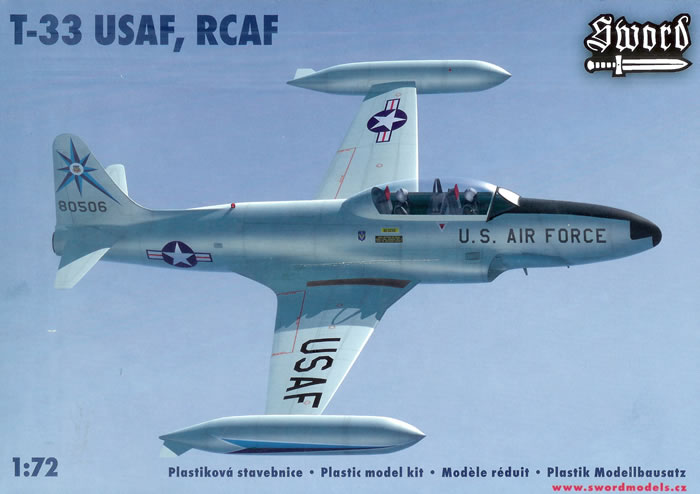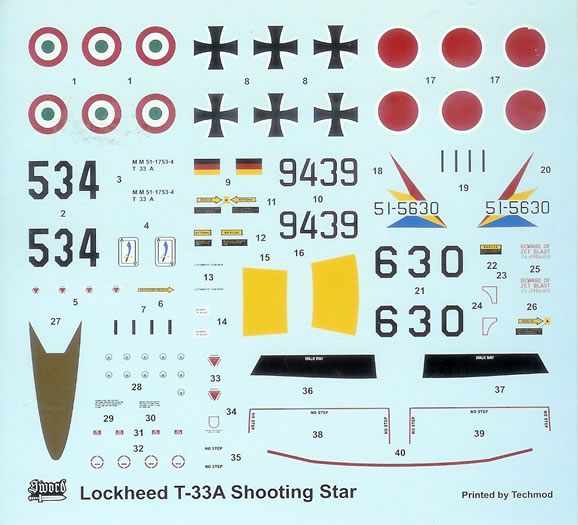Lockheed T-33 Shooting Star

Sword, 1/72 scale
S u m m a r y : |
Catalogue Number: |
SW72027 Lockheed T-33 USAF, RCAF
SW72028 Lockheed T-33 JASDF, Bundesluftwaffe, Aeronautica Milittaire |
Scale: |
1/72 |
Contents & Media |
49 x styrene, 2 x clear styrene, 7 x resin parts, and decals for two or three subjects for SW2027 and 72028 respectively. |
Price: |
Available online from Hannants for £12.76 , Squadron for US$26.96, and Modelimex for €14.58 |
Review Type: |
First Look. |
Advantages: |
Nice lines, fine panel lines and generally good detail levels for the scale. |
Disadvantages: |
The horizontal split of the intakes may make for some difficulties. Resin wheels may have been a better option over styrene. Different ejector sets may be needed if you build the Luftwaffe version. |
Conclusions: |
A very nice kit of an attractive subject. |
Reviewed by
Mark Davies

HyperScale is proudly sponsored by
Squadron.com
Background
The first US jet aircraft was the Bell P-59, but an altogether better design that flew just a little later was the Lockheed P-80. It was the product of a brilliant Lockheed “Skunk Works” design team led by “Kelly” Johnson. The first airframe was developed and delivered within a staggering 143 days, and the prototype first flew in January 1944. Just missing combat in WW2, the P-80, later to be redesignated F-80, was to see active service as a fighter, fighter-bomber and photo reconnaissance platform in the Korean War. By this time it was already overshadowed in the fighter role by the superlative F-86 Sabre.
Early on Lockheed had suggested the development of a 2-seat P-80 to the USAF, but the air force brass did not appreciate the need for a jet trainer at the time. However, as the difficulties in transitioning from piston-engined types to jets became more apparent there was a change in official thinking by 1947.
Developed form the P-80C, the TF-80C (soon to be redesignated T-33) introduced tandem seating and a long canopy. A 26” plug was inserted in the cockpit area, and the mid-fuselage was extended by a further 12“. Armament was reduced from six to two .50” M3 machineguns (although many T-33’s had no guns fitted). It first flew in March 1948.

The T-33 was an outstanding success and widely exported to over 30 countries, as well as being licence-produced in Canada. Light attack and photo reconnaissance variants were also developed. The design was further developed and highly modified for US Navy use, and known as the T2V –1/T-1A Seastar. This had a raised cockpit line, leading-edge slats, tail hook for carrier landings, and was the first US aircraft to have boundary layer control using engine bleed-air. Finally, a radar-equipped after-burning all-weather interceptor was derived from the T-33 as the F-94 Starfire.
Almost 6,600 T-33 Shooting Stars were produced, and several are still flying in private hands as warbirds.
Previous 1/72 T-33 Shooting Stars
I am aware of two previous T-33 kits in 1/72 scale. Perhaps the more readily available is the fairly old kit by Hasegawa. It is one of their older kits with fine raised surface detail, and generally rather basic detail levels. This has been offered in several different boxings over the years. Heller produced a very nice kit some time after Hasegawa. This too has raised panel detail, but offers superior levels of detail, and I have read that it is the more accurate of the two. So given that both of these kits are showing their age a bit, I feel that a modern and readily available injected T-33 kit is most welcome.
Both kits come in a typically Czech end-opening boxes with attractive artwork on the front. The instructions provide a parts map, and easy to follow diagrammatic assembly format. There is also a brief history of the aircraft. Text is in Czech and English. Painting and decal guides are quite adequate black & white shaded 4-view drawings. Generic colour call outs are provided for detail parts and airframe.
I have numerous Sword kits, and these are typical in that the plastic has a more shiny finish than many other Czech brands. All parts are quite cleanly moulded with very fine engraved surface detail. Sprue gates are narrow, and some small amounts of flash are present in places, but this can be easily removed. The resin parts are produced to high standards.
The cockpit is reasonably well catered for with a styrene tub; joysticks, instrument panels plus coaming, along with nicely detailed resin ejector seats. However I know that German T-33’s were fitted with Martin Baker seats at some stage. These are quite different to the standard T-33 seat, so a substitute seat may be required if you build this version There is a choice of instrument panel for both front and rear seats, but no clear guide on which should be used for which version. So if in doubt, get those references out. Some may wish to add more detail to the tub sidewalls, as these are a bit plain. Resin inserts provide excellent detail for the nose and main wheel wells, the latter include the inside detail for the ventral air-brakes. Resin also caters for the landing lights fitted to the front undercarriage leg. The clear canopy is injected, provided as two parts, and is quite thin in section. A resin canopy insert, representing the internal bracing is also provided.
Most of the finer styrene parts are well moulded with acceptable detail, but the wheels fall just a little short of ideal. Their spoke pattern is not quite as crisp as it might be, revealing the limitations of Sword’s moulding technology. I think resin wheels could have been justified here. To be fair, they are not bad, but not perfect either. There are two nose wheels supplied, and although the instructions indicate a choice is available, no guidance is provided as to which version should have which wheel.
Construction sequence and parts breakdown is generally conventional for the type, but the horizontal split of the air intakes could make for possible fit and seam problems. However tooling the intakes as a one piece would have led to a circumferential seam that could be just as awkward, so it will all come down to how well the parts actually fit. Aside from this aspect it looks as if it should be a very straightforward build.
The decal options are quite attractive.
Boxing #72027 has one US and one Canadian option.

Boxing #72028 offers one scheme each for Japanese, German and Italian aircraft. The anti-glare panel is also provided as a decal, and this should help avoid having to mask varying radius curves.

The decals look to be well registered with good opacity.
This is a really nicely engineered kit that is produced to generally high standards. It has the potential to produce a very good model of the T-33, and is a distinct advance over both the older kits from Hasegawa and Heller.
I am hoping Sword will consider releasing F-94B & C Starfires to take over form the Heller and Emhar kits respectively, although hoping for a Seastar may be a wish too far.
Definitely recommended.
Thanks to Sword Models for this review sample.
Review Text & Images Copyright © 2010 by Mark Davies
Page Created 1 September, 2010
Last updated
1 September, 2010
Back to HyperScale Main Page

|
